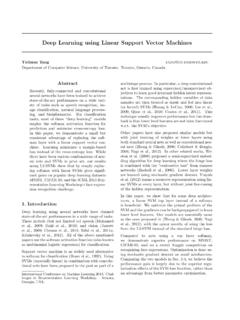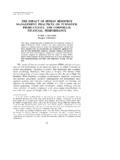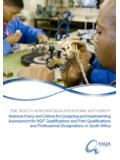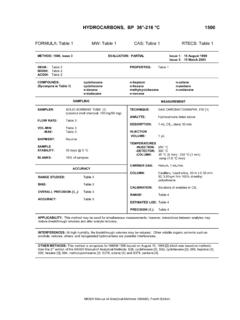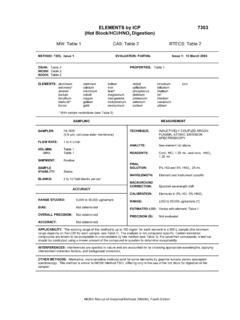Transcription of Five Qualitative Approaches to Inquiry - SAGE …
1 4 five QualitativeApproaches to InquiryIn this chapter, we begin our detailed exploration of narrative research,phenomenology, grounded theory, ethnography, and case studies. For eachapproach, I pose a definition, briefly trace its history, explore types of stud-ies, introduce procedures involved in conducting a study, and indicate poten-tial challenges in using the approach. I also review some of the similarities anddifferences among the five Approaches so that Qualitative researchers candecide which approach is best to use for their particular for Discussion What are a narrative study, a phenomenology, a grounded theory, an ethnog-raphy, and a case study?
2 What are the procedures and challenges to using each approach to qualitativeresearch? What are some similarities and differences among the five Approaches ?Narrative ResearchDefinition and BackgroundNarrative research has many forms, uses a variety of analytic practices,and is rooted in different social and humanities disciplines (Daiute & 11/28/2006 3:39 PM Page 53 Lightfoot, 2004). Narrative might be the term assigned to any text ordiscourse, or, it might be text used within the context of a mode of inquiryin Qualitative research (Chase, 2005), with a specific focus on the stories toldby individuals (Polkinghorne, 1995).
3 As Pinnegar and Daynes (2006) sug-gest, narrative can be both a method and the phenomenonof study. As amethod, it begins with the experiences as expressed in lived and told storiesof individuals. Writers have provided ways for analyzing and understandingthe stories lived and told. I will define it here as a specific type of qualitativedesign in which narrative is understood as a spoken or written text givingan account of an event/action or series of events/actions, chronologicallyconnected (Czarniawska, 2004, p.)
4 17). The procedures for implementingthis research consist of focusing on studying one or two individuals, gather-ing data through the collection of their stories, reporting individual experi-ences, and chronologically ordering (or usinglife course stages) the meaningof those narrative research originated from literature, history, anthro-pology, sociology, sociolinguistics, and education, different fields of studyhave adopted their own Approaches (Chase, 2005). I find a postmodern,organizational orientation in Czarniawska (2004); a human developmentalperspective in Daiute and Lightfoot (2004); a psychological approachinLieblich, Tuval-Mashiach, and Zilber (1998); sociological Approaches inCortazzi (1993) and Riessman (1993); and quantitative ( , statistical sto-ries in event history modeling) and Qualitative Approaches in Elliott (2005).
5 Interdisciplinary efforts at narrative research have also been encouragedby the Narrative Study of Livesannual series that began in 1993 (see, , Josselson & Lieblich, 1993), and the journal Narrative Inquiry . Withmany recent books on narrative research, it is indeed a field in the making (Chase, 2005, p. 651). In the discussion of narrative procedures, I rely onan accessible book written for social scientists called Narrative Inquiry (Clandinin & Connelly, 2000) that addresses what narrative researchersdo (p.)
6 48).Types of Narrative StudiesOne approach to narrative research is to differentiate types of narrativeresearch by the analytic strategies used by authors. Polkinghorne (1995)takes this approach and distinguishes between analysis of narratives (p. 12), using paradigm thinking to create descriptions of themes that holdacross stories or taxonomies of types of stories, and narrative analysis, inwhich researchers collect descriptions of events or happenings and then con-figure them into a story using a plot line.
7 Polkinghorne (1995) goes on to54 Qualitative Inquiry and Research 11/28/2006 3:39 PM Page 54emphasize the second form in his writings. More recently, Chase (2005)presents an approach closely allied with Polkinghorne s analysis of narra-tives. Chase suggests that researchers may use paradigmatic reasons for anarrative study, such as how individuals are enabled and constrained bysocial resources, socially situated in interactive performances, and how nar-rators develop second approach is to emphasize the variety of forms found in narra-tive research practices (see, , Casey, 1995/1996).
8 A biographical studyisa form of narrative study in which the researcher writes and records theexperiences of another person s life. Autobiography is written and recordedby the individuals who are the subject of the study (Ellis, 2004). A lifehistoryportrays an individual s entire life, while a personal experience storyis a narrative study of an individual s personal experience found in single ormultiple episodes, private situations, or communal folklore (Denzin, 1989a).An oral historyconsists of gathering personal reflections of events andtheir causes and effects from one individual or several individuals (Plummer,1983).
9 Narrative studies may have a specific contextual focus, such asteachers or children in classrooms (Ollerenshaw & Creswell, 2002), or thestories told about organizations (Czarniawska, 2004). Narratives may beguided by a theoretical lens or perspective. The lens may be used to advocatefor Latin Americans through using testimonios (Beverly, 2005), or it may bea feminist lens used to report the stories of women (see, , PersonalNarratives Group, 1989), a lens that shows how women s voices are muted,multiple, and contradictory (Chase, 2005).
10 Procedures for Conducting Narrative ResearchUsing the approach taken by Clandinin and Connelly (2000) as a generalprocedural guide, the methods of conducting a narrative study do not followa lock-step approach, but instead represent an informal collection of Determine if the research problem or question best fits narrativeresearch. Narrative research is best for capturing the detailed stories or lifeexperiences of a single life or the lives of a small number of Select one or more individuals who have stories or life experiences totell, and spend considerable time with them gathering their stories throughmultiples types of information.










